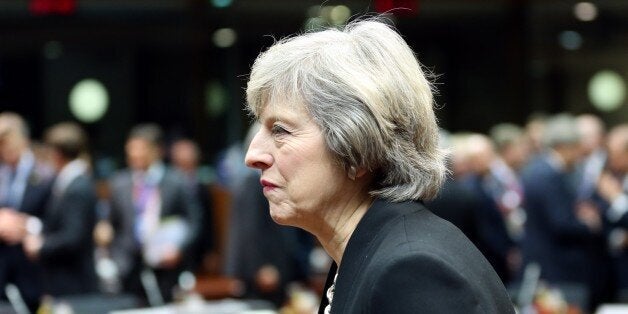
It may be that on Thursday in Brussels Theresa May unexpectedly created the defining image of her premiership.
Politicians often have defining moments when their image crystallises in the public mind. Sometimes it is a small incident and often it is unfair. For Neil Kinnock it was when a photo opportunity stroll along the beach with his wife went wrong as the tide rushed in and he slipped over. It gave the impression he was accident prone. For William Hague it was coming down a waterslide, wearing a baseball cap on backwards, which suggested this articulate clever man was really a bit of a lightweight. For Ed Miliband, it came late on with trying to eat a bacon sandwich and then the "Ed stone" image, which all suggested this very nice person was just a bit odd.
Thursday's image of Theresa May standing alone and ignored at the start of the Brussels summit, whilst European leaders all around her were greeting and backslapping each other, may be the moment when her image crystallised in the public consciousness.
May is seen to be standing and looking around to find someone to talk to, but no one wanted to talk to her. She sat down alone and looked uncomfortable. The image suggested someone regarded as unimportant by other European leaders, who felt vulnerable and, crucially, did not know how to deal with it.
The image played repeatedly on television on Thursday night and featured in the morning newspapers. Millions of voters will have noticed it because cringe worthy events like this get noticed.
To many busy, not particularly politically engaged, voters Theresa May was a surprise Prime Minister. Although she had been a relatively successful Home Secretary, she had deliberately kept a low profile. Her way of tackling the perils of a department famously described by a predecessor as "not fit for purpose", was to avoid publicity. This worked, but it also meant the public never got to know Theresa May. Then, her selection as Prime Minister occurred without the kind of proper campaign which would have enabled her to introduce herself to voters. She was selected because her last opponent, Andrea Leadsom, dropped out before party members got a chance to vote.Therefore the first time most nonpolitical voters noticed Theresa May was when she emerged as the new Conservative leader, standing on the threshold of 10 Downing Street, saying that she wanted to fight for "the people who are just managing". It was a good speech and a good enough image for people to both register her as the new Prime Minister and also to want to give her a chance.But since then there have been no big events that have enabled her to create a defining image. Then at the Brussels meeting, when something unexpected happened.The Brussels meeting was politically important, so the media were there. European leaders were going to meet later that evening over dinner to discuss the EU stance on Brexit, without Theresa May. It was therefore of symbolic significance that on the same day as she was excluded from EU discussions she allowed the impression to be created that she was not worth talking to. It is not the image that the British people expect of their Prime Minister. No one can imagine Margaret Thatcher or Tony Blair allowing that impression to be given. They would have confidently walked across the room to talk to another leader. They would never have been ignored.
As with Kinnock, Haig and Miliband, the real problem is when a picture reflects a deeper reality. This is a new government struggling to deal with the unexpected Brexit decision and everyone knows it. The government has been repeatedly accused of lacking a plan. The divisions and tensions within the government are plain to see. Even the "Three Brexiteers" given the task of dealing with the detail of the exit negotiations, Liam Fox, David Davis and Boris Johnson, don't much like each other.
So the television pictures of Theresa May in Brussels reflected the impression of a floundering government. The fact that the problems are primarily caused by the refusal of David Cameron to allow officials to prepare for Brexit is not the point. Voters expect their governments to always have a policy and know what to do next, because leaders are there to lead. A Prime Minister cannot afford to give the impression of being the victim of the events. In Brussels on Thursday, Theresa May looked to the entire world like a person who was not in control of events. She will now struggle to live down that image.
Mike O'Brien is a former Labour MP and Home and Foreign Office Minister